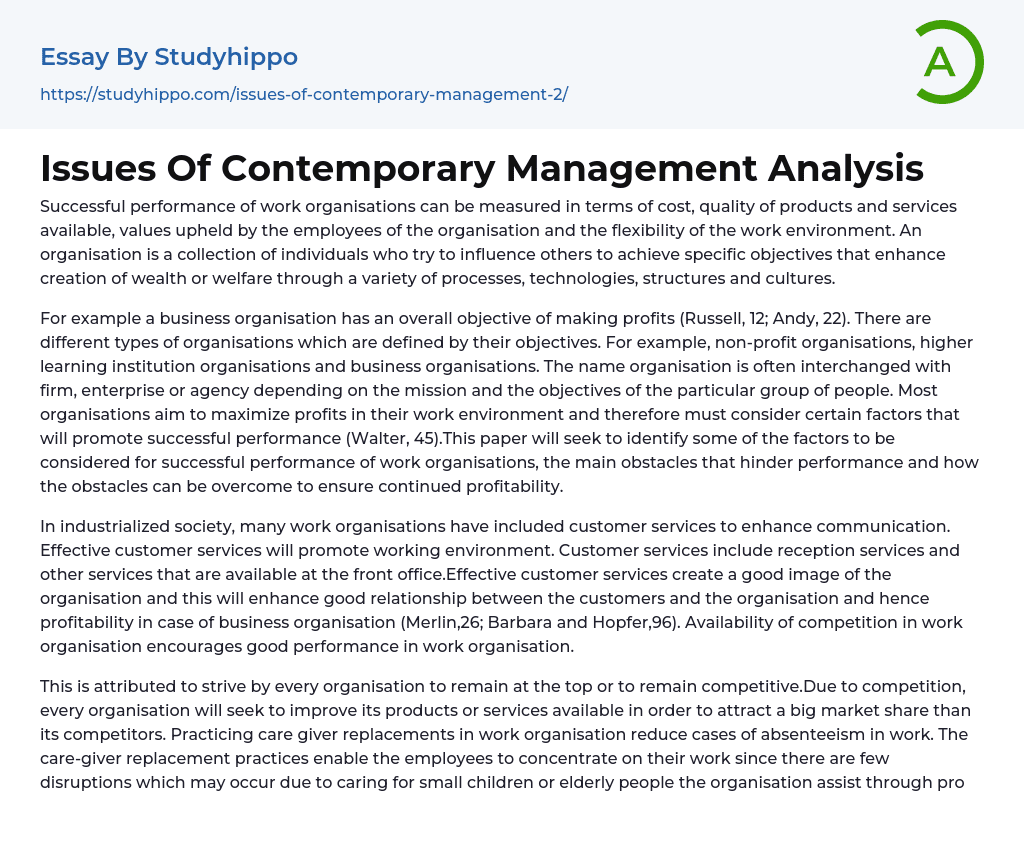The evaluation of work organizations' performance can be conducted by considering factors like cost, quality, employee values, and work environment flexibility. An organization is defined as a group of people who aim to influence others in order to accomplish specific objectives that contribute to wealth or welfare. This is achieved through different processes, technologies, structures, and cultures. For example, the primary focus of a business organization is profit generation (Russell, 12; Andy, 22). The goals of various organizations are determined according to their nature, whether they are non-profit organizations, higher education institutions or business organizations.
The terms organization, firm, enterprise, and agency are often used interchangeably depending on the goals and objectives of a specific group of individuals. Most organizations strive to maximize profits in their work environment, and in order to do so, they must take into account certain factors that contribute to suc
...cessful performance (Walter, 45). This article aims to identify these performance-enhancing factors, as well as the main hurdles that impede performance and strategies for overcoming these obstacles to ensure ongoing profitability. In today's industrialized society, many work organizations have incorporated customer services as a means to enhance communication.
Effective customer services play a crucial role in improving the working environment.
Customer services offered at the front office are essential for creating a positive perception of the organization. These services, including reception services and others, contribute to building a strong relationship between the organization and its customers. Ultimately, this enhances profitability for businesses (Merlin, 26; Barbara and Hopfer, 96).
Competition within organizations drives improved performance as they aim to maintain their competitive advantage. This motivation pushes organizations to enhance their products or services in order
to attract more customers than their competitors. Introducing caregiver replacements in workplaces helps reduce instances of absenteeism.
The organization offers caregiving services like on-site or subsidized childcare, elder care support, and laundry services to help employees care for their children or elderly family members. These caregiver replacement practices minimize disruptions and allow employees to focus on their work. Although providing these services may come with high costs, the benefits outweigh the expense. By offering flexible schedules, workers can adjust their hours and activities to accommodate family responsibilities. This flexibility includes options such as choosing schedules, job sharing, paid family and medical leaves, and overtime special payment. Flexible work hours have advantages such as more efficient labor use, increased employee effort and satisfaction, and the ability for employees to recharge and stay motivated. This ultimately improves productivity and contributes to the success of the organization. Furthermore, flexible work practices have been found to increase female labor force participation.
Favourable government policies that promote sustainability of organisations can lead to successful performance of work organisation. For instance, most non-profit Non-governmental organisations (NGOs) like Red-Cross and World Vision are exempted from such policies and this promotes the achievement of their set objectives. These objectives involve assisting those who are marginalized due to poverty, natural calamities such as droughts, floods, and earthquakes. The provision of good security also plays a role in improving the work environment and the welfare of the marginalized society (Merlin, 25; Russell, 31). Strong supplier and partnering relationships also contribute to the success of work organizations. This is because they ensure timely supply of goods and services required by the organization for its work, which in turn
enhances continuity.
To maintain a harmonious work environment, it is essential to have strong partnerships that prevent conflicts arising from issues such as salaries, work atmosphere, and profitability.
- Leadership and Management essays
- Change Management essays
- Project Management essays
- Knowledge Management essays
- Operations Management essays
- Quality Management essays
- Risk Management essays
- Scientific Management essays
- supply chain management essays
- Performance Management essays
- Time Management essays
- Brand Management essays
- Total Quality Management essays
- Risk essays
- Manager essays
- Leadership essays
- Business Ethics essays
- Board Of Directors essays
- Product Management essays
- Comparative Analysis essays
- Decision Making essays
- Dispute Resolution essays
- Stress Management essays
- Business Management essays
- Brand Equity essays
- Branding essays
- Nike, Inc. essays
- Market share essays
- Razor essays
- Being A Leader essays
- Servant Leadership essays
- Leadership Experience essays
- Leadership Qualities essays
- Incentive essays
- Business Analysis essays
- Business Plan essays
- Community Development essays
- Competition essays
- Effective Leadership essays
- Leadership Styles essays
- Mission Statement essays
- Negotiation essays
- Outsourcing essays
- Planning essays
- Public relations essays
- Reasoning essays
- Strategic Management essays
- Strategic Planning essays
- Swot Analysis essays
- American Dream essays




